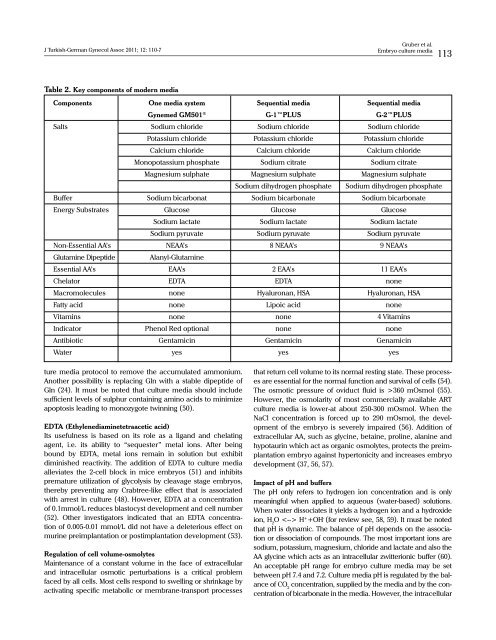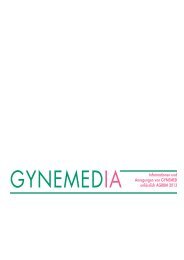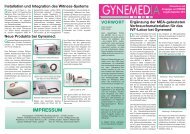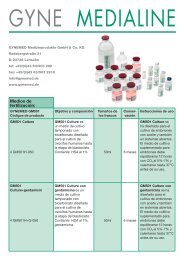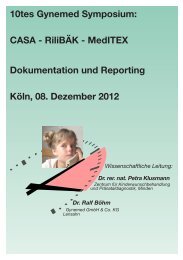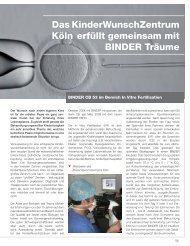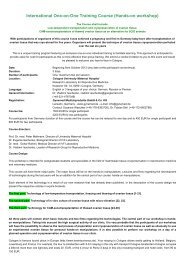Embryo culture media for human IVF: which ... - JournalAgent
Embryo culture media for human IVF: which ... - JournalAgent
Embryo culture media for human IVF: which ... - JournalAgent
You also want an ePaper? Increase the reach of your titles
YUMPU automatically turns print PDFs into web optimized ePapers that Google loves.
J Turkish-German Gynecol Assoc 2011; 12: 110-7<br />
Table 2. Key components of modern <strong>media</strong><br />
Components One <strong>media</strong> system Sequential <strong>media</strong> Sequential <strong>media</strong><br />
Gynemed GM501 ® G-1PLUS G-2PLUS<br />
Salts Sodium chloride Sodium chloride Sodium chloride<br />
Potassium chloride Potassium chloride Potassium chloride<br />
Calcium chloride Calcium chloride Calcium chloride<br />
Monopotassium phosphate Sodium citrate Sodium citrate<br />
Magnesium sulphate Magnesium sulphate Magnesium sulphate<br />
Sodium dihydrogen phosphate Sodium dihydrogen phosphate<br />
Buffer Sodium bicarbonat Sodium bicarbonate Sodium bicarbonate<br />
Energy Substrates Glucose Glucose Glucose<br />
Sodium lactate Sodium lactate Sodium lactate<br />
Sodium pyruvate Sodium pyruvate Sodium pyruvate<br />
Non-Essential AA’s NEAA’s 8 NEAA’s 9 NEAA’s<br />
Glutamine Dipeptide Alanyl-Glutamine<br />
Essential AA’s EAA’s 2 EAA’s 11 EAA’s<br />
Chelator EDTA EDTA none<br />
Macromolecules none Hyaluronan, HSA Hyaluronan, HSA<br />
Fatty acid none Lipoic acid none<br />
Vitamins none none 4 Vitamins<br />
Indicator Phenol Red optional none none<br />
Antibiotic Gentamicin Gentamicin Genamicin<br />
Water yes yes yes<br />
ture <strong>media</strong> protocol to remove the accumulated ammonium.<br />
Another possibility is replacing Gln with a stable dipeptide of<br />
Gln (24). It must be noted that <strong>culture</strong> <strong>media</strong> should include<br />
sufficient levels of sulphur containing amino acids to minimize<br />
apoptosis leading to monozygote twinning (50).<br />
EDTA (Ethylenediaminetetraacetic acid)<br />
Its usefulness is based on its role as a ligand and chelating<br />
agent, i.e. its ability to “sequester” metal ions. After being<br />
bound by EDTA, metal ions remain in solution but exhibit<br />
diminished reactivity. The addition of EDTA to <strong>culture</strong> <strong>media</strong><br />
alleviates the 2-cell block in mice embryos (51) and inhibits<br />
premature utilization of glycolysis by cleavage stage embryos,<br />
thereby preventing any Crabtree-like effect that is associated<br />
with arrest in <strong>culture</strong> (48). However, EDTA at a concentration<br />
of 0.1mmol/L reduces blastocyst development and cell number<br />
(52). Other investigators indicated that an EDTA concentration<br />
of 0.005-0.01 mmol/L did not have a deleterious effect on<br />
murine preimplantation or postimplantation development (53).<br />
Regulation of cell volume-osmolytes<br />
Maintenance of a constant volume in the face of extracellular<br />
and intracellular osmotic perturbations is a critical problem<br />
faced by all cells. Most cells respond to swelling or shrinkage by<br />
activating specific metabolic or membrane-transport processes<br />
Gruber et al.<br />
<strong>Embryo</strong> <strong>culture</strong> <strong>media</strong> 113<br />
that return cell volume to its normal resting state. These processes<br />
are essential <strong>for</strong> the normal function and survival of cells (54).<br />
The osmotic pressure of oviduct fluid is >360 mOsmol (55).<br />
However, the osmolarity of most commercially available ART<br />
<strong>culture</strong> <strong>media</strong> is lower-at about 250-300 mOsmol. When the<br />
NaCl concentration is <strong>for</strong>ced up to 290 mOsmol, the development<br />
of the embryo is severely impaired (56). Addition of<br />
extracellular AA, such as glycine, betaine, proline, alanine and<br />
hypotaurin <strong>which</strong> act as organic osmolytes, protects the preimplantation<br />
embryo against hypertonicity and increases embryo<br />
development (37, 56, 57).<br />
Impact of pH and buffers<br />
The pH only refers to hydrogen ion concentration and is only<br />
meaningful when applied to aqueous (water-based) solutions.<br />
When water dissociates it yields a hydrogen ion and a hydroxide<br />
ion, H 2 O H + +OH - (<strong>for</strong> review see, 58, 59). It must be noted<br />
that pH is dynamic. The balance of pH depends on the association<br />
or dissociation of compounds. The most important ions are<br />
sodium, potassium, magnesium, chloride and lactate and also the<br />
AA glycine <strong>which</strong> acts as an intracellular zwitterionic buffer (60).<br />
An acceptable pH range <strong>for</strong> embryo <strong>culture</strong> <strong>media</strong> may be set<br />
between pH 7.4 and 7.2. Culture <strong>media</strong> pH is regulated by the balance<br />
of CO 2 concentration, supplied by the <strong>media</strong> and by the concentration<br />
of bicarbonate in the <strong>media</strong>. However, the intracellular


